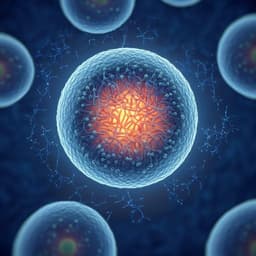
Engineering and Technology
Elucidating the origin of chiroptical activity in chiral 2D perovskites through nano-confined growth
S. Ma, Y. Jung, et al.
Discover the intriguing world of chiral perovskites! This research conducted by Sunihl Ma, Young-Kwang Jung, Jihoon Ahn, and others delves into how nano-confined growth and asymmetric hydrogen bonding are driving chiroptical activity, paving the way for advanced spintronic and optoelectronic devices.
~3 min • Beginner • English
Introduction
Chiral photonics based on chiroptical phenomena has garnered significant interest across opto-spintronics, information processing, biosensing, and quantum computing. Chiral materials exhibit nonlinear optical responses dependent on circular polarization due to their non-centrosymmetric nature, but conventional organic chiral materials typically operate in the near-UV and suffer from poor charge transport. In 2017, chiral organic-inorganic hybrid perovskites (OIHPs) were identified as a new class of chiral semiconductors showing circular dichroism (CD) when incorporating chiral organic ammonium cations. Subsequent reports on chiral OIHPs (nanocrystals, co-gels, nanoplatelets, thin films) revealed unusual spin-related properties (strong spin–orbit coupling, Rashba splitting, long spin lifetime and diffusion length) and low-temperature circularly polarized photoluminescence (CPPL). Despite these advances, the mechanism of chirality transfer from chiral bulky organic cations to the achiral lead-halide framework remains debated. Proposed mechanisms include: (i) chiral crystal structures induced by chiral molecules, (ii) chiral surface distortions, (iii) chiral dislocations, and (iv) electronic interactions between chiral organics and inorganic frameworks. While structural mechanisms have often been invoked, emerging evidence suggests that electronic coupling between the spacer’s π-system and inorganic halide p-orbitals can tune electronic configurations in quasi-2D OIHPs. This study investigates the origin of chiroptical activity by modulating electronic interactions through nano-confined growth to impose micro-strain, thereby altering π–π stacking and hydrogen bonding, and examines how these changes influence CD and CPPL, including signal amplification and handedness switching.
Literature Review
Prior work established chiral OIHPs as promising materials exhibiting CD and CPPL, with notable spin physics such as strong spin–orbit coupling and Rashba-type effects leading to long spin lifetimes and diffusion lengths. Long et al. demonstrated low-temperature CPPL without magnetic fields by tuning inorganic layer numbers. Historically, chirality transfer has been attributed to structure-property relationships, including chiral space groups (e.g., P212121), surface distortions, and dislocations. However, electronic-interaction-based mechanisms have been less explored. Recent studies showed that spacer cations with delocalized π-electrons can strongly interact with halide p-orbitals, modifying electronic configurations and potentially facilitating chirality transfer. The authors also reference thin-film measurement artifacts (LD/ LB induced apparent CD) and the necessity of Mueller matrix considerations when assessing macroscopic anisotropic films. Collectively, the literature suggests multiple possible chirality transfer pathways, motivating a systematic study to disentangle structural from electronic interaction effects and to control them via strain engineering.
Methodology
- Materials and growth: Chiral 2D perovskite thin films based on MBA₂PbI₄(1−x)Br₄x were prepared using identical precursor solutions. Films were deposited by spin coating on planar glass (0 nm pore size) and on anodized aluminum oxide (AAO) templates with different pore sizes (66, 100, 112 nm), followed by annealing. Low precursor concentration was used to prevent overlayer formation atop the AAO, ensuring focus on nanoconfined crystals within pores.
- Nanoconfined growth: AAO templates impose spatial confinement, modifying crystallization kinetics and introducing micro-strain. Prior work indicates such confinement can yield single-crystalline growth within pores and suppress horizontal growth.
- Chiroptical characterization: Circular dichroism (CD) spectra were measured for films grown on different substrates. The asymmetry factor g_CD was calculated as g_CD = CD/(32980 × extinction). To exclude macroscopic anisotropy contributions (LDLB), measurements were performed from both front and back sides, and the true CD was obtained by semi-sum: CD_true = 0.5 × (CD_obs,front + CD_obs,back). Bare AAO templates were characterized to rule out their intrinsic optical anisotropy above 350 nm.
- Structural analysis and micro-strain: X-ray diffraction (XRD) was collected for various substrates and compositions. Micro-strain was quantified using a modified Williamson–Hall analysis, benchmarking against strain-free single-crystal MBA₂PbI₄. Peak positions and broadening were analyzed to estimate lattice strain along the c-axis under confinement.
- Photoluminescence (PL): Steady-state PL spectra were recorded to corroborate strain via emission energy shifts and to assess defect/trap state influence. FE (free exciton) versus STE (self-trapped exciton) contributions were quantified via intensity ratio I_FE/I_STE.
- Composition and control studies: The bromide fraction x was varied from 0.325 to 0.400 to test generality. Racemic MBA₂PbBrxI4−x (x=0.325) films were used as controls to verify absence of chiroptical signals without chirality and to confirm AAO does not induce artifacts.
- Spectral deconvolution and exciton coupling: CD spectra near the first extinction band edge were deconvoluted into multiple excitonic transitions. Excited-state splitting (2V12) was extracted, relating to dipole–dipole coupling, and its variation with pore size examined.
- First-principles calculations: DFT (VASP; PAW; PBE-GGA with DFT-D dispersion corrections) was performed on R-MBA₂PbI₄ model structures. Uniaxial and biaxial strains were applied to analyze intra-octahedral distortions (bond length distortion Δd and bond angle variance σ²) and hydrogen-bond lengths between NH3+ groups (HB_top1, HB_top2, HB_bot1, HB_bot2) and inorganic iodides as a function of micro-strain.
- CPPL measurements: Room-temperature circularly polarized photoluminescence (CPPL) was measured using a 450 nm excitation with polarization optics and a detector setup. The CPPL asymmetry factor g_CPPL = (I_L − I_R)/(I_L + I_R) was computed. Angle-dependent excitation tests were conducted to rule out incident-angle effects. Racemic samples were measured under identical CPPL conditions to exclude SOC/Rashba-only origins of CPPL without chirality transfer.
Key Findings
- Strong amplification of chiroptical signals under nanoconfinement: g_CD at the first extinction band edge increased from 3.8 × 10⁻⁴ (planar) to 2.0 × 10⁻³ (100 nm AAO), a 5.12-fold improvement.
- Sign and shape conversions: Cotton effect sign switched from positive (planar) to negative (AAO-templated); spectral shape changed from unisignate (planar) to bisignate (AAO), consistent across pore sizes and also across compositions x = 0.350–0.400.
- Artifact exclusion: Bare AAO showed no CD above 350 nm; front/back semi-sum analysis removed LDLB artifacts, confirming true CD amplification stems from confinement. Racemic films exhibited no CD in 425–525 nm regardless of substrate, confirming chiral origin of effects.
- Structural observations: XRD showed iodide-dominant phase (2θ ≈ 6.2°) with only marginal shifts; thus, chiroptical changes are not due to phase switching between iodide- and bromide-dominant phases.
- Micro-strain behavior: Modified Williamson–Hall analysis revealed a non-monotonic (zigzag) dependence of micro-strain on AAO pore size, attributed to flexible π–π stacking of organic spacers in 2D OIHPs under confinement. PL emission energies exhibited a similar zigzag trend, corroborating strain effects.
- Exciton coupling: Deconvolution of CD revealed bisignate features and enabled extraction of excited-state splitting (2V12), which also varied in a zigzag manner with pore size, paralleling micro-strain and PL shifts, indicating strain-modulated excitonic interactions and chirality transfer efficiency.
- DFT insights: Under compressive micro-strain along c (negative uniaxial/positive biaxial), intra-octahedral distortions (Δd, σ²) increased, and hydrogen-bond asymmetry among NH3+ … I interactions (HB_top1/2, HB_bot1/2) was amplified. This asymmetry supports enhanced chirality transfer from organic spacers to the inorganic framework.
- CPPL performance: Room-temperature g_CPPL reached 6.4 × 10⁻² for R-MBA₂PbI₄(1−x)Br₄x (x=0.325) in 100 nm AAO, with S-enantiomer yielding −4.4 × 10⁻². Sign of CPPL switched from σ− (planar) to σ+ (AAO), matching CD sign changes. FE emission centered at ~495 nm near the first extinction band edge (~475 nm), indicating common ground/excited states underlying CD and CPPL.
- Reduced lattice distortion signatures: I_FE/I_STE increased from 1.43 (planar) to 3.19 (100 nm AAO), suggesting improved crystal quality and that enhanced chiroptics arise from asymmetric hydrogen bonding rather than increased framework distortion.
- Controls on SOC/Rashba effects: Racemic AAO-confined samples showed no CPPL differences between LCP/RCP excitation, indicating enhanced g_CPPL in chiral samples stems from chirality transfer (which may concomitantly enable Rashba-Dresselhaus effects) rather than SOC alone.
Discussion
The study demonstrates that nano-confined growth imposes micro-strain that reorganizes π–π stacking of chiral spacer cations (MBA⁺), thereby modulating asymmetric NH3+ … I hydrogen bonding with the inorganic framework. This enhances electronic interactions between organic and inorganic sublattices, facilitating chirality transfer and producing significant changes in chiroptical responses: amplified g_CD, sign inversion, and bisignate CD near the inorganic excitonic band edge. Correlated trends in micro-strain, PL emission energy, and excited-state splitting confirm that strain tunes excitonic coupling. Artifact controls (front/back CD semi-sums, bare AAO characterization, and racemic references) support that observed effects are intrinsic to the chiral perovskites under confinement, not measurement-induced anisotropy or template artifacts. The findings shift the mechanistic emphasis from solely crystallographic chirality to include electronic and dipolar interactions mediated by hydrogen-bond asymmetry, explaining room-temperature CPPL with high g_CPPL and its sign switching. These insights are relevant for engineering chiral perovskites in spintronic and polarization-based optoelectronics, where controlled electronic coupling and hydrogen-bond asymmetry can be leveraged to tailor spin-polarized emission and detection.
Conclusion
By employing strain engineering via nano-confined growth in AAO templates, the work elucidates that asymmetric hydrogen-bonding between chiral organic spacers and the achiral lead-halide framework is a key driver of chiroptical activity in chiral 2D perovskites. Confinement-induced micro-strain reorganizes π–π stacking, enhances electronic coupling, and facilitates chirality transfer, yielding amplified CD (g_CD up to 2.0 × 10⁻³), sign inversion of Cotton effects, bisignate CD features, and record-high room-temperature CPPL (g_CPPL up to 6.4 × 10⁻²). DFT shows that compressive strain along c increases intra-octahedral distortion and hydrogen-bond asymmetry, consistent with enhanced chirality transfer. These results highlight electronic interaction engineering—beyond crystal symmetry control—as a powerful design axis for chiral hybrid materials. Future research could generalize this approach to other chiral spacers and halide compositions, integrate operando probes to directly resolve hydrogen bonding and local structure under strain, and translate the enhanced chiroptical responses into device architectures for spintronic and polarization-resolved optoelectronics.
Limitations
- Material scope: Experiments focus on MBA₂PbI₄(1−x)Br₄x with x ≈ 0.325–0.400 and an MBA⁺ spacer; generalization to other chiral cations and broader compositions remains to be demonstrated.
- Strain quantification: Micro-strain is inferred from XRD broadening via modified Williamson–Hall analysis and correlated PL shifts; direct nanoscale strain mapping was not reported.
- Structural resolution: Asymmetric hydrogen bonding is supported by DFT rather than direct experimental observation (e.g., neutron/advanced X-ray scattering sensitive to H positions) in strained films.
- Device-level validation: The study demonstrates enhanced CD/CPPL in films but does not include device measurements linking chiroptical performance to operational figures of merit.
- Temperature range and environment: CPPL enhancements are shown at room temperature under specific excitation conditions; stability and performance under varied environmental and electrical biases were not explored.
Related Publications
Explore these studies to deepen your understanding of the subject.







